

|
| ÖSTERREICH | AUSTRIA |
| Bundesland: Tirol | Tyrol |
| Stadt: Innsbruck |
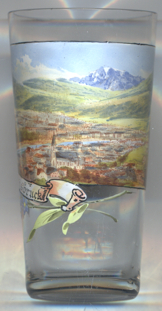
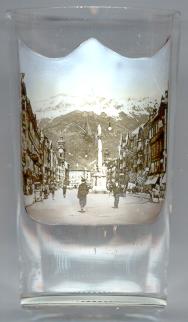 Archeological finds in the area of Innsbruck show that the area was
already inhabited in prehistoric times. The Romans built a civil and military settlement
at the Via Claudia Augusta in AD 46/47. This settlement, called Veldidena, later became
the village of Wilten (see below) which today is part of the municipality of Innsbruck.
Around 1165–1170 the Bavarian Counts of Andechs founded a settlement north of
the river Inn (today the cadastral district Hötting) and also built a bridge
across the river. This place was first mentioned in 1167/1183 as Inspruk (German 'Brücke' = bridge).
From 1180 the Counts of Andechs (now Dukes of Andechs-Meranien) also obtained the area south of the bridge. This
part of the town later developed into today's centre of the old town. Already
in 1187/1204 Innsbruck obtained the freedom of the city. Innsbruck became
part of Tyrol in 1263 and came into possession of the Habsburgs in 1363. From
1420 it became ducal residence and the centre of the province. The appearance of
the old town is still determined by the buildings that were erected under
Emperor Maximilian I (1459–1519), Emperor Ferdinand I (1503–1564),
Archduke Ferdinand II (1529–1595) and Archduke Leopold V (1586–1632) of Tyrol,
and Empress Maria Theresia (1717–1780). During the 19th century the construction of
the railway lines from Innsbruck to Munich (1856–1858),
via the Brenner pass to Bozen/Bolzano in South Tyrol (now Italy) (1864–1867)
and across the Arlberg to Bludenz and Bregenz
in Vorarlberg (1882–1884) initiated a major period of industrial growth. Innsbruck
was host of the Olympic Winter Games twice, in 1964 and in 1979.
Archeological finds in the area of Innsbruck show that the area was
already inhabited in prehistoric times. The Romans built a civil and military settlement
at the Via Claudia Augusta in AD 46/47. This settlement, called Veldidena, later became
the village of Wilten (see below) which today is part of the municipality of Innsbruck.
Around 1165–1170 the Bavarian Counts of Andechs founded a settlement north of
the river Inn (today the cadastral district Hötting) and also built a bridge
across the river. This place was first mentioned in 1167/1183 as Inspruk (German 'Brücke' = bridge).
From 1180 the Counts of Andechs (now Dukes of Andechs-Meranien) also obtained the area south of the bridge. This
part of the town later developed into today's centre of the old town. Already
in 1187/1204 Innsbruck obtained the freedom of the city. Innsbruck became
part of Tyrol in 1263 and came into possession of the Habsburgs in 1363. From
1420 it became ducal residence and the centre of the province. The appearance of
the old town is still determined by the buildings that were erected under
Emperor Maximilian I (1459–1519), Emperor Ferdinand I (1503–1564),
Archduke Ferdinand II (1529–1595) and Archduke Leopold V (1586–1632) of Tyrol,
and Empress Maria Theresia (1717–1780). During the 19th century the construction of
the railway lines from Innsbruck to Munich (1856–1858),
via the Brenner pass to Bozen/Bolzano in South Tyrol (now Italy) (1864–1867)
and across the Arlberg to Bludenz and Bregenz
in Vorarlberg (1882–1884) initiated a major period of industrial growth. Innsbruck
was host of the Olympic Winter Games twice, in 1964 and in 1979.
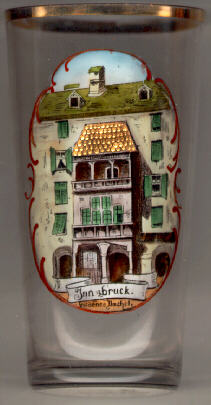
 Goldenes Dachl (Golden Roof) [left]
is Innsbruck's premier landmark. The state-oriel was built by Niklas Türing the Elder
1497/98–1500 by order of Maximilian I for the celebration of the year 1500.
The roof is made of gilded copper which was the origin of its popular name.
The building had served as a second town residence before the reign of Maximilian.
Since 1996 it houses the Museum Maximilianeum.
Goldenes Dachl (Golden Roof) [left]
is Innsbruck's premier landmark. The state-oriel was built by Niklas Türing the Elder
1497/98–1500 by order of Maximilian I for the celebration of the year 1500.
The roof is made of gilded copper which was the origin of its popular name.
The building had served as a second town residence before the reign of Maximilian.
Since 1996 it houses the Museum Maximilianeum.
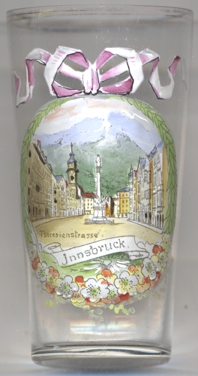
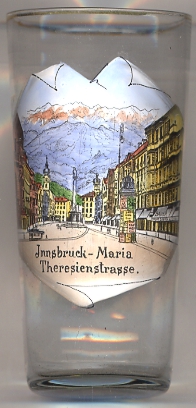
The  Maria-Theresien-Straße [left and right] was named after
Maria Theresia (1717–1780), Archduchess of Austria, Queen of Hungary and Bohemia. Her husband Franz Stephan Duke of Lorraine
(1708–1765) was elected Emperor (Franz I) of the Holy Roman Empire in 1745.
Maria-Theresien-Straße [left and right] was named after
Maria Theresia (1717–1780), Archduchess of Austria, Queen of Hungary and Bohemia. Her husband Franz Stephan Duke of Lorraine
(1708–1765) was elected Emperor (Franz I) of the Holy Roman Empire in 1745.
The  Spitalskirche zum Heiigen Geist (Hospital Church of the Holy Spirit) [background left]
was first mentioned in 1389. This oldest church was rebuilt in 1596. After severely being damaged by an earthquake in 1689, the present,
Baroque, church was built by the architect Johann Martin Gumpp (the Elder) in 1700–1705. In 1945, the church was heavily damaged by
Allied bomb raids, but was restored after the war.
Spitalskirche zum Heiigen Geist (Hospital Church of the Holy Spirit) [background left]
was first mentioned in 1389. This oldest church was rebuilt in 1596. After severely being damaged by an earthquake in 1689, the present,
Baroque, church was built by the architect Johann Martin Gumpp (the Elder) in 1700–1705. In 1945, the church was heavily damaged by
Allied bomb raids, but was restored after the war.
[https://de.wikipedia.org/wiki/Spitalskirche_(Innsbruck)]
The  Annasäule (St. Anne's Column) [foreground centre]
was created in 1704–1706 by order of the Tyrolean estates. It received its name from the fact that during the War of the Spanish Succession
on 26 July (St. Anne's Day) 1703 the last Bavarian troops were driven out of Tyrol. The column was made by Trient
sculptor, Cristoforo Benedetti, from red Kramsach marble. On the base are four statues of saints: St. Anne, St. Cassian,
St. Vigilius and St. George. Towering above these four statues is the column with its statue of Mary as the Woman of the Apocalypse,
raising 42 meters from the street. The statue of Our Lady was replaced by a replica in 1958 and the original was loaned to the Abbey of
Sankt Georgenberg-Fiecht near Schwaz. The statues of the four saints were replaced by replicas in 2009, the originals
of those statues are now housed in the Old Landhaus.
Annasäule (St. Anne's Column) [foreground centre]
was created in 1704–1706 by order of the Tyrolean estates. It received its name from the fact that during the War of the Spanish Succession
on 26 July (St. Anne's Day) 1703 the last Bavarian troops were driven out of Tyrol. The column was made by Trient
sculptor, Cristoforo Benedetti, from red Kramsach marble. On the base are four statues of saints: St. Anne, St. Cassian,
St. Vigilius and St. George. Towering above these four statues is the column with its statue of Mary as the Woman of the Apocalypse,
raising 42 meters from the street. The statue of Our Lady was replaced by a replica in 1958 and the original was loaned to the Abbey of
Sankt Georgenberg-Fiecht near Schwaz. The statues of the four saints were replaced by replicas in 2009, the originals
of those statues are now housed in the Old Landhaus.
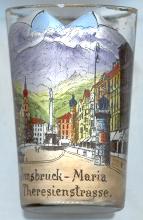
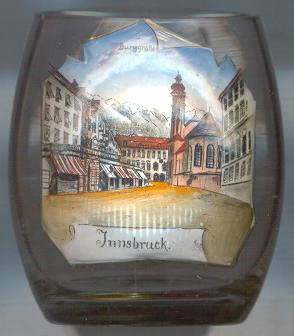
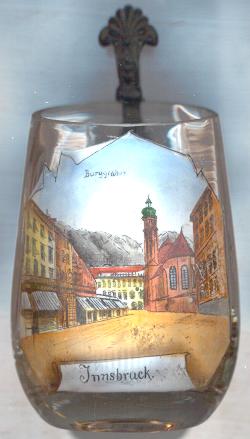
The  Hofkirche (Court Church) [left and below right] was built in
1553–1563 in Late Gothic and Early Renaissance style by Emperor Ferdinand I as a burial church for his grandfather,
Emperor Maximilian I. In 1508, Maximilian himself had commissioned 40 bronze statues (larger than life) of important
members from the House of Habsburg. In 1519, at the time of Maximilian's death in Wels,
10 statues were completed, 18 were completed until 1550. In his last will Maximilian had decided to be buried
in the chapel of his residence in Wiener Neustadt. The 28 statues (nicknamed "die Schwarzen Mannder",
"the Black Men"), 34 busts of Roman Emperors, and further 23 smaller statues of saints, however, remained in
Innsbruck. Ferdinand I had them set up in the Hofkirche around the splendid (but empty) tomb of Maximilian.
Hofkirche (Court Church) [left and below right] was built in
1553–1563 in Late Gothic and Early Renaissance style by Emperor Ferdinand I as a burial church for his grandfather,
Emperor Maximilian I. In 1508, Maximilian himself had commissioned 40 bronze statues (larger than life) of important
members from the House of Habsburg. In 1519, at the time of Maximilian's death in Wels,
10 statues were completed, 18 were completed until 1550. In his last will Maximilian had decided to be buried
in the chapel of his residence in Wiener Neustadt. The 28 statues (nicknamed "die Schwarzen Mannder",
"the Black Men"), 34 busts of Roman Emperors, and further 23 smaller statues of saints, however, remained in
Innsbruck. Ferdinand I had them set up in the Hofkirche around the splendid (but empty) tomb of Maximilian.
The leader of the Tyrolean uprising in 1809 against Bavaria and France, Andreas Hofer (1767–1810) was buried in the Hofkirche in 1823, thirteen years after being court-martialled and executed in Mantova, Italy, on Napoleon's instruction. Only after Napoleon's defeat in the "Battle of Nations" in Leipzig in 1813 and the Congress of Vienna in 1814/1815, Tyrol became part of Austria again.
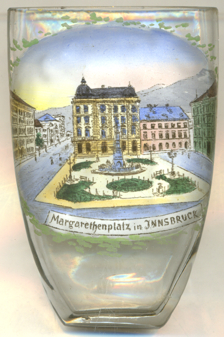
The square  Margaretenplatz
Margaretenplatz
The  Rudolfsbrunnen
Rudolfsbrunnen
[https://de.wikipedia.org/wiki/Bozner_Platz]
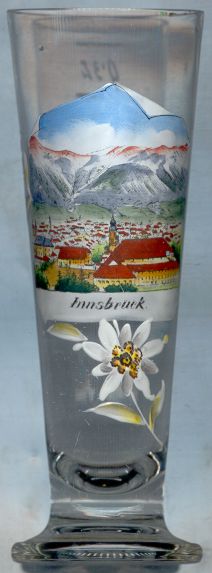
According to a legend,  Wilten Monastery [left no. 1743: foreground right]
was founded in 880 AD; in fact, it is more likely that it was founded before 1138 by bishop Reginbert of
Brixen (Bressanone), who called in Premonstratensians from the Upper Swabian monastery of
Rot an der Rot who replaced a prior collegiate of secular priests. The monastery obtained papal approval in 1138.
Beneath the monastery biuldings, remains of the Roman village Veldidena were discovered. The monastery was
closed between 1807 and 1816 due to a ruling of the kingdom of Bavaria. During the Nazi period, the monastery was
forced to sell the complex to the Reichsgau Tirol-Vorarlberg. After the bombings during World War II (in 1943 and 1944,
the monastery had to be reconstructed; these works were completed only in 1988 on the 850th anniversary of its foundation.
Wilten Monastery [left no. 1743: foreground right]
was founded in 880 AD; in fact, it is more likely that it was founded before 1138 by bishop Reginbert of
Brixen (Bressanone), who called in Premonstratensians from the Upper Swabian monastery of
Rot an der Rot who replaced a prior collegiate of secular priests. The monastery obtained papal approval in 1138.
Beneath the monastery biuldings, remains of the Roman village Veldidena were discovered. The monastery was
closed between 1807 and 1816 due to a ruling of the kingdom of Bavaria. During the Nazi period, the monastery was
forced to sell the complex to the Reichsgau Tirol-Vorarlberg. After the bombings during World War II (in 1943 and 1944,
the monastery had to be reconstructed; these works were completed only in 1988 on the 850th anniversary of its foundation.
The  monastery church was built in splendid Baroque style by court architect Christoph
Gumpp and was consecrated in by the bishop of Brixen (Bressanone) in 1665. The church replaced
the earlier Gothic church which had been destroyed by the collapse of its tower. The north tower was completed in 1667,
while the south tower was never completed.
monastery church was built in splendid Baroque style by court architect Christoph
Gumpp and was consecrated in by the bishop of Brixen (Bressanone) in 1665. The church replaced
the earlier Gothic church which had been destroyed by the collapse of its tower. The north tower was completed in 1667,
while the south tower was never completed.
[https://de.wikipedia.org/wiki/Stift_Wilten]
The
 Wilten Basilica (parish church and basilica of our Lady of the Immaculate Conception)
[left no. 1743: far left, barely visible] was built in 1751–1756 in Rococo style.
Several churches have stood in its place already before. Archeological studies show that the earliest of these
churches dated from the early 5th century, i.e. the Roman period. Already since the 13th century, the place
had been a popular pilgrimage site. In 1957 the church obtained the status of a Basilica minor by decree
of Pope Pius XII.
(see also list of other basilicae minores depicted on glasses of this collection)
Wilten Basilica (parish church and basilica of our Lady of the Immaculate Conception)
[left no. 1743: far left, barely visible] was built in 1751–1756 in Rococo style.
Several churches have stood in its place already before. Archeological studies show that the earliest of these
churches dated from the early 5th century, i.e. the Roman period. Already since the 13th century, the place
had been a popular pilgrimage site. In 1957 the church obtained the status of a Basilica minor by decree
of Pope Pius XII.
(see also list of other basilicae minores depicted on glasses of this collection)
[https://de.wikipedia.org/wiki/Wiltener_Basilika]

The  monument for Andreas Hofer on Bergisel [left, no. 4746] was created between
1889 and 1892 according to a design by the sculptor Heinrich Natter. The Bergisel was the scene of the four decisive battles of the
Tyrolean popular uprising under Andreas Hofer in 1809. The larger-than-life bronze statue stands on a base made of Bozen (Bolzano)
porphyry, which weighs around ten tons. In 1961, the monument was blown up by unknown assailants. The statue broke off above the
ankles and fell on its back. It was restored by the Graßmayr bell foundry and re-erected two months after the attack.
monument for Andreas Hofer on Bergisel [left, no. 4746] was created between
1889 and 1892 according to a design by the sculptor Heinrich Natter. The Bergisel was the scene of the four decisive battles of the
Tyrolean popular uprising under Andreas Hofer in 1809. The larger-than-life bronze statue stands on a base made of Bozen (Bolzano)
porphyry, which weighs around ten tons. In 1961, the monument was blown up by unknown assailants. The statue broke off above the
ankles and fell on its back. It was restored by the Graßmayr bell foundry and re-erected two months after the attack.
[https://de.wikipedia.org/wiki/Andreas-Hofer-Denkmal_(Bergisel)]
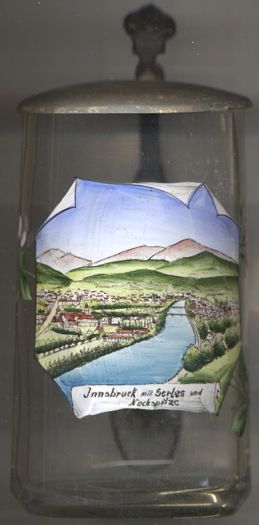
The picture on glass no. 4575 [near left] shows an aerial view of Innsbruck looking south. Two of the mountains depicted
in the background are indentified in the labeling of the picture: Serles and Nockspitze:
 Serles (2,718 m) [background, far left], also sometimes named Waldrastspitze is part of the Stubai
Alps, between the Stubai Valley and the Wipptal. Due to being prominently seen from Innsbruck and also because of its overall shape it is popularly nicknamed
the High Altar of Innsbruck. Another common nickname, King Serles, goes back to an old folk tale, according to which the main peak is an evil king who was
petrified as punishment, the two secondary peaks are his sons (or acording to other versions also other family members, who were also petrified.
Serles (2,718 m) [background, far left], also sometimes named Waldrastspitze is part of the Stubai
Alps, between the Stubai Valley and the Wipptal. Due to being prominently seen from Innsbruck and also because of its overall shape it is popularly nicknamed
the High Altar of Innsbruck. Another common nickname, King Serles, goes back to an old folk tale, according to which the main peak is an evil king who was
petrified as punishment, the two secondary peaks are his sons (or acording to other versions also other family members, who were also petrified.
[https://de.wikipedia.org/wiki/Serles, https://en.wikipedia.org/wiki/Serles]
 Saile or Hohe Saile (2,404 m), in Tyrol most frequently called Nockspitze [background right],
marks the northeastern end of the Stubai Alps. Due to its particularly exposed location, the Saile is considered a 'weather mountain', i.e. a point where
thunderstorms, storms and snowfalls arise. It was therefore seen in folk legends as the main meeting place for the weather witches, who performed their dance
at night on the mountain's broad summit plateau and sent bad weather down to the valley.
Saile or Hohe Saile (2,404 m), in Tyrol most frequently called Nockspitze [background right],
marks the northeastern end of the Stubai Alps. Due to its particularly exposed location, the Saile is considered a 'weather mountain', i.e. a point where
thunderstorms, storms and snowfalls arise. It was therefore seen in folk legends as the main meeting place for the weather witches, who performed their dance
at night on the mountain's broad summit plateau and sent bad weather down to the valley.
[https://de.wikipedia.org/wiki/Saile_(Berg)]
![[scale]](lineal.jpg)